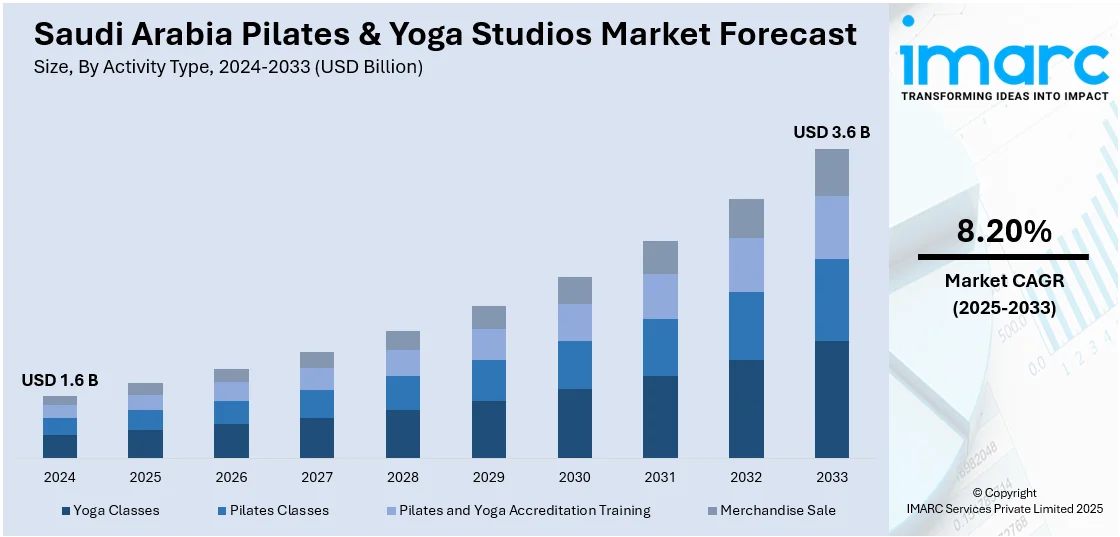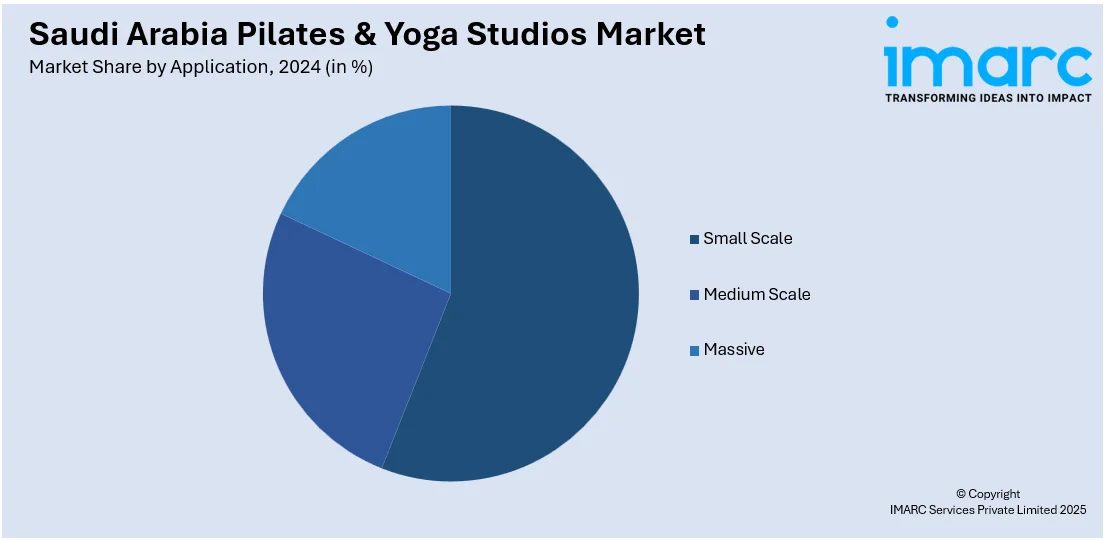
Saudi Arabia Pilates & Yoga Studios Market Size, Share, Trends and Forecast by Activity Type, Application, and Region, 2025-2033
Saudi Arabia Pilates & Yoga Studios Market Overview:
The Saudi Arabia pilates & yoga studios market size reached USD 1.6 Billion in 2024. Looking forward, IMARC Group expects the market to reach USD 3.6 Billion by 2033, exhibiting a growth rate (CAGR) of 8.20% during 2025-2033. The market is driven by the growing female engagement in sporting activities and wellness pursuits, heightened consciousness about physical fitness and mental health among the masses, and focus on creating avenues for private sector participation in the wellness industry.
|
Report Attribute
|
Key Statistics
|
|---|---|
|
Base Year
|
2024
|
|
Forecast Years
|
2025-2033
|
|
Historical Years
|
2019-2024
|
| Market Size in 2024 | USD 1.6 Billion |
| Market Forecast in 2033 | USD 3.6 Billion |
| Market Growth Rate (2025-2033) | 8.20% |
Saudi Arabia Pilates & Yoga Studios Market Trends:
Rising Health and Wellness Awareness Among the Population
The growing consciousness about physical fitness and mental health is one major factor driving the market in Saudi Arabia. Part of an international trend, more people in the Kingdom are making healthier lifestyles a priority, spurred by increasing worries about sedentary lifestyles, obesity, and chronic diseases like diabetes and high blood pressure. The General Authority for Statistics (GASTAT) released the 2024 Health Determinants Statistics Publication for Saudi Arabia. The publication indicated that 23.1% of the population aged 15 and over is obese, while 45.1% of the same age group is overweight. The Ministry of Health and concerned authorities are initiating various programs to encourage physical activity, in accordance with the Vision 2030 goal of enhancing the quality of life of citizens. Yoga and Pilates are especially attractive because they treat both body and mind. They decrease stress, improve posture, and increase flexibility without the intensity of conventional gym exercise. As individuals look for integrated health solutions, demand for specialized studios is experiencing consistent growth, particularly in urban centers.

Government Initiatives and Policy Reforms Supporting the Fitness Sector
The Saudi Arabian government's Vision 2030 reforms are playing a crucial role in fostering a fitness-friendly environment. Under the overall economic diversification strategy, the government is creating avenues for private sector participation in the wellness industry, eased licensing regulations, and assisted in the creation of sports and recreational enterprises. All these reforms are served to decrease entry barriers considerably, encouraging local entrepreneurs and foreign franchises to open Pilates and yoga studios. Aside from regulatory and financial support, public-private partnerships and public campaigns are instituted to urge citizens, particularly youth and women, to engage in physical activity. Public-private partnerships, the Ministry of Sports, and the General Sports Authority are joining hands to establish infrastructure and facilitate community fitness initiatives. In 2024, the Saudi Yoga Committee entered into a cooperation agreement with the Ministry of Human Resources and Social Development to popularize yoga as a lifestyle in the community. This partnership acted as a turning point in recognizing and integrating yoga into Saudi society.
Growing Female Participation in the Fitness Industry
The growing female engagement in sporting activities and wellness pursuits is offering a favorable market outlook in Saudi Arabia. According to a news article by Maaal published in 2025, the percentage of women’s involvement in sports in Sadi Arabia increased by more than 150% from the launch of Vision 2030 initiatives. Societal shifts are enabling women to take a proactive approach towards fitness and wellness. Yoga and Pilates, which are seen as low-impact and accommodating of different levels of fitness, are particularly favored by women. The spread of women-only gyms, in addition to the emergence of female fitness influencers on social media platforms, is also further driving this trend. Female-only studios are in high demand, with specialized training programs, women instructors, and culturally specific studio atmospheres serving as strong selling points within city and suburban markets.
Saudi Arabia Pilates & Yoga Studios Market Segmentation:
IMARC Group provides an analysis of the key trends in each segment of the market, along with forecasts at the region level for 2025-2033. Our report has categorized the market based on activity type and application.
Activity Type Insights:
- Yoga Classes
- Pilates Classes
- Pilates and Yoga Accreditation Training
- Merchandise Sale
The report has provided a detailed breakup and analysis of the market based on the activity type. This includes yoga classes, Pilates classes, Pilates and yoga accreditation training, and merchandise sale.
Application Insights:

- Small Scale
- Medium Scale
- Massive
A detailed breakup and analysis of the market based on the application have also been provided in the report. This includes small scale, medium scale, and massive.
Regional Insights:
- Northern and Central Region
- Western Region
- Eastern Region
- Southern Region
The report has also provided a comprehensive analysis of all the major regional markets, which include northern and central region, western region, eastern region, and southern region.
Competitive Landscape:
The market research report has also provided a comprehensive analysis of the competitive landscape. Competitive analysis such as market structure, key player positioning, top winning strategies, competitive dashboard, and company evaluation quadrant has been covered in the report. Also, detailed profiles of all major companies have been provided.
Saudi Arabia Pilates & Yoga Studios Market Report Coverage:
| Report Features | Details |
|---|---|
| Base Year of the Analysis | 2024 |
| Historical Period | 2019-2024 |
| Forecast Period | 2025-2033 |
| Units | Billion USD |
| Scope of the Report |
Exploration of Historical Trends and Market Outlook, Industry Catalysts and Challenges, Segment-Wise Historical and Future Market Assessment:
|
| Activity Types Covered | Yoga Classes, Pilates Classes, Pilates and Yoga Accreditation Training, Merchandise Sale |
| Applications Covered | Small Scale, Medium Scale, Massive |
| Regions Covered | Northern and Central Region, Western Region, Eastern Region, Southern Region |
| Customization Scope | 10% Free Customization |
| Post-Sale Analyst Support | 10-12 Weeks |
| Delivery Format | PDF and Excel through Email (We can also provide the editable version of the report in PPT/Word format on special request) |
Key Questions Answered in This Report:
- How has the Saudi Arabia Pilates & yoga studios market performed so far and how will it perform in the coming years?
- What is the breakup of the Saudi Arabia Pilates & yoga studios market on the basis of activity type?
- What is the breakup of the Saudi Arabia Pilates & yoga studios market on the basis of application?
- What is the breakup of the Saudi Arabia Pilates & yoga studios market on the basis of region?
- What are the various stages in the value chain of the Saudi Arabia Pilates & yoga studios market?
- What are the key driving factors and challenges in the Saudi Arabia Pilates & yoga studios market?
- What is the structure of the Saudi Arabia Pilates & yoga studios market and who are the key players?
- What is the degree of competition in the Saudi Arabia Pilates & yoga studios market?
Key Benefits for Stakeholders:
- IMARC’s industry report offers a comprehensive quantitative analysis of various market segments, historical and current market trends, market forecasts, and dynamics of the Saudi Arabia Pilates & yoga studios market from 2019-2033.
- The research report provides the latest information on the market drivers, challenges, and opportunities in the Saudi Arabia Pilates & yoga studios market.
- Porter's five forces analysis assist stakeholders in assessing the impact of new entrants, competitive rivalry, supplier power, buyer power, and the threat of substitution. It helps stakeholders to analyze the level of competition within the Saudi Arabia Pilates & yoga studios industry and its attractiveness.
- Competitive landscape allows stakeholders to understand their competitive environment and provides an insight into the current positions of key players in the market.
Need more help?
- Speak to our experienced analysts for insights on the current market scenarios.
- Include additional segments and countries to customize the report as per your requirement.
- Gain an unparalleled competitive advantage in your domain by understanding how to utilize the report and positively impacting your operations and revenue.
- For further assistance, please connect with our analysts.
 Request Customization
Request Customization
 Speak to an Analyst
Speak to an Analyst
 Request Brochure
Request Brochure
 Inquire Before Buying
Inquire Before Buying




.webp)




.webp)












